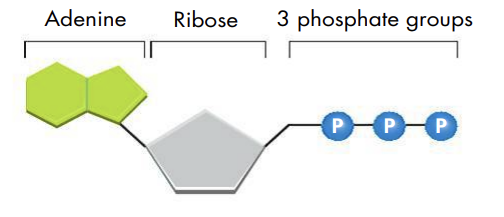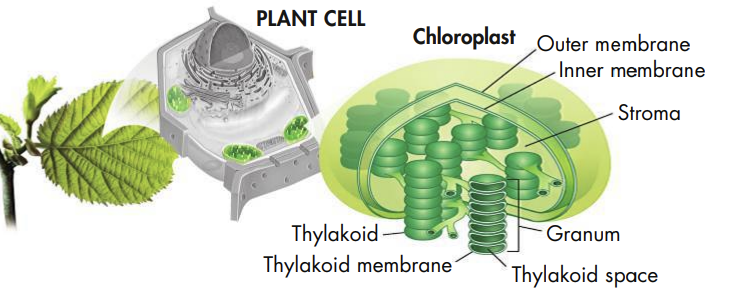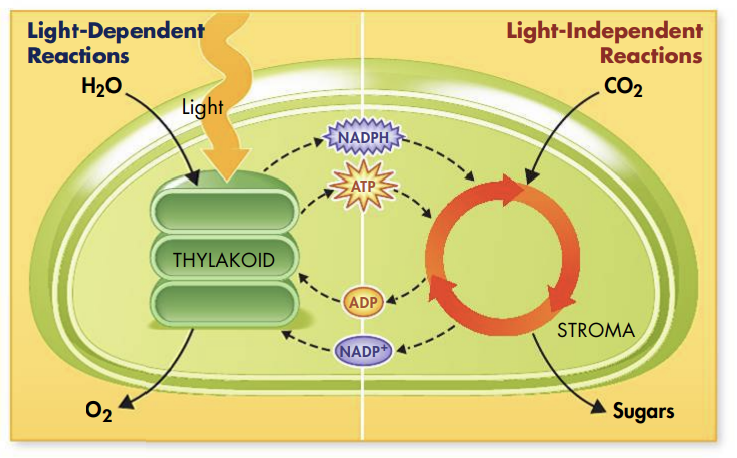
Chapter 8: Photosynthesis
8.1 Energy and Life
Chemical Energy
Energy is the ability to do work
Objects such as lights, radios, and computers, as well as living things, need energy to work
Without the ability to get and use energy, cells would die
Light, heat, electricity, and chemical energy are four forms of energy
Energy can change from one form to another
Chemical energy is the energy stored in chemical bonds
One of the principal chemical compounds that living things use to store and release energy is called adenosine triphosphate (ATP)
ATP is made up of adenine, a sugar called ribose, and three phosphate groups
The phosphate groups are the key to why ATP can store and release energy

Adenosine diphosphate (ADP) is similar to ATP but has only two phosphate groups instead of three
When a cell has extra energy, it can store small amounts of it by adding a phosphate group to ADP molecules, which turns ADP into ATP
Cells can give off the energy stored in ATP by breaking the chemical bonds between the second and third phosphate groups
A cell can add or subtract these phosphate groups whenever it needs to store or use energy
Cells use ATP in many ways
ATP powers active transport by providing the energy needed to move material into and out of many cells.
ATP also helps proteins in muscles to slide closer together, a motion that makes muscles flex
Energy from ATP powers many other important events, such as the making of proteins and responses to chemical signals outside of the cell
Most cells only have a small amount of ATP
ATP is great for giving off a small amount of energy very quickly, but it is not good for storing large amounts for a long time
Glucose is much better for energy storage, as a single glucose molecule stores more than 90 times the energy of a molecule of ATP
Cells can then use the stored glucose to make ATP and ADP as needed
ATP Comes From Food
ATP comes from the chemical compounds that we call food, though different living things get their food from different sources
Living things that get food by eating other living things are known as heterotrophs
Some heterotrophs get their food by eating plants such as grasses, while others get food by eating other animals; other heterotrophs—mushrooms, for example—get food by breaking down the tissues of dead things
Living things that make their own food are called autotrophs
The process by which autotrophs use the energy of sunlight to produce high-energy carbohydrates—sugars and starches—that can be used as food is known as photosynthesis
8.2 Photosynthesis: An Overview
Chlorophyll and Chloroplasts
Living things that carry out photosynthesis use pigments to get energy from sunlight
Energy from the sun travels to Earth in the form of light
Sunlight, which our eyes see as “white” light, is actually a mixture of different wavelengths
Plants gather the sun’s energy with light-absorbing molecules called pigments
The most important pigment in plants is chlorophyll, which absorbs blue-violet light and red light best, though it does not absorb green light very well; leaves look green because they reflect green light
Photosynthesis takes place inside organelles called chloroplasts
These organelles hold many flat, bag-shaped membranes called thylakoids, which are connected to one another and arranged in stacks called grana
Chlorophyll and other pigments are found in these thylakoid membranes
The liquid-filled space around the thylakoids is known as the stroma

High-Energy Electrons
When chlorophyll takes in light, much of that energy is moved directly to electrons in the chlorophyll, causing their energy levels to rise
A stream of these high-energy electrons is what makes photosynthesis work
However, these high-energy electrons cannot keep their energy for long on their own and need a special carrier
Plant cells use molecules to carry high-energy electrons from chlorophyll to other places
One of these carrier molecules is NADP+ (nicotinamide adenine dinucleotide phosphate), and it accepts and holds two high-energy electrons, along with a hydrogen ion (H+), a process that changes NADP+ into NADPH
The NADPH carries the electrons to other parts of the cell, where the electrons and their energy can be used to help build useful molecules, such as sugars
A Summary of Photosynthesis
Photosynthesis uses light energy to change water and carbon dioxide (reactants) into sugars and oxygen (products)
All of the steps of photosynthesis can be summed up in the following equation:

There are two stages of photosynthesis: light-dependent reactions and light-independent reactions
Light-dependent reactions are reactions of photosynthesis that use ATP, NADPH, and carbon dioxide to make high-energy sugars
These reactions take place in the thylakoids and release oxygen
Light-independent reactions are reactions of photosynthesis that use light energy to make ATP and NADPH
These reactions take place in the stroma

8.3 The Process of Photosynthesis
The Light-Dependent Reactions: Making ATP and NADPH
The light-dependent reactions take place in the thylakoids of chloroplasts, where they hold groups of chlorophyll and proteins known as photosystems that take in sunlight and use it to add energy to electrons; these electrons are passed to a set of carriers in the thylakoid membrane
There are two photosystems, and they are named in order of their discovery—not in the order that they do their work
The pigments of photosystem II absorb light energy and release high-energy electrons that then get passed down the electron transport chain, a series of proteins in which high-energy electrons are used to change ADP to ATP
The light-dependent reactions use water and energy from sunlight to make oxygen and change ADP and NADP+ into the energy carriers ATP and NADPH; these compounds are important for the cell because they provide the energy needed to build sugars in the light-independent reactions
In sum:
Photosystem II: Light shining on pigments energizes electrons that come from water
Electron Transport: High-energy electrons move down the chain, which pumps H+ ions to the inside of the thylakoid
Photosystem I: Electrons are reenergized with more light
Electron Transport: The reenergized electrons are transferred to NADP+, to make NADPH
ATP Formation: Excess H+ ions spill out through ATP synthase; the protein rotates as each ion passes through, which changes ADP to ATP
Light-Independent Reactions: Making Sugars
During the light-independent reactions—also called the Calvin cycle—plants build high-energy sugars
These sugars are stable, so they can store energy for a long time
The Calvin cycle is named after the American scientist Melvin Calvin
During the light-independent reactions, ATP and NADPH are used to make high-energy sugars
The plant uses the sugars to meet its energy needs and to build molecules needed for growth; when other living things eat plants, they, too, get the energy they need
In sum:
Step 1: Carbon dioxide combines with molecules from the cycle that have five carbon atoms; molecules with three carbon atoms result
Step 2: Energy from ATP and NADPH energizes the 3-carbon-atom molecules
Step 3: Some of these molecules leave the cycle to make sugars and other compounds
Step 4: Energy from ATP changes the rest of the 3-carbon-atom molecules back into 5-carbon-atom molecules
Step 5: The 5-carbon-atom molecules can go through the cycle again
Factors Affecting Photosynthesis
Three important factors that affect photosynthesis are temperature, light intensity, and the availability of water
Temperature is one factor that can affect the rate of photosynthesis, as photosynthesis enzymes work best between 0°C and 35°C
Light intensity is another factor, as very bright light speeds up photosynthesis
Water levels also affect the rate of photosynthesis
Extreme conditions can also affect photosynthesis
Plants that close tiny openings in their leaves to keep from drying out in the hot can’t receive as much carbon dioxide; in turn, this slows photosynthesis
C4 plants have a special chemical pathway that gets carbon into the Calvin cycle even when there is not much carbon dioxide available
The pathway uses extra ATP but lets the plants carry out photosynthesis when it is hot
CAM plants save water by taking air into their leaves only at night
In the dark, carbon dioxide is used to make acids
During the day, these acids are turned back into carbon dioxide for photosynthesis
Chapter 8: Photosynthesis
8.1 Energy and Life
Chemical Energy
Energy is the ability to do work
Objects such as lights, radios, and computers, as well as living things, need energy to work
Without the ability to get and use energy, cells would die
Light, heat, electricity, and chemical energy are four forms of energy
Energy can change from one form to another
Chemical energy is the energy stored in chemical bonds
One of the principal chemical compounds that living things use to store and release energy is called adenosine triphosphate (ATP)
ATP is made up of adenine, a sugar called ribose, and three phosphate groups
The phosphate groups are the key to why ATP can store and release energy

Adenosine diphosphate (ADP) is similar to ATP but has only two phosphate groups instead of three
When a cell has extra energy, it can store small amounts of it by adding a phosphate group to ADP molecules, which turns ADP into ATP
Cells can give off the energy stored in ATP by breaking the chemical bonds between the second and third phosphate groups
A cell can add or subtract these phosphate groups whenever it needs to store or use energy
Cells use ATP in many ways
ATP powers active transport by providing the energy needed to move material into and out of many cells.
ATP also helps proteins in muscles to slide closer together, a motion that makes muscles flex
Energy from ATP powers many other important events, such as the making of proteins and responses to chemical signals outside of the cell
Most cells only have a small amount of ATP
ATP is great for giving off a small amount of energy very quickly, but it is not good for storing large amounts for a long time
Glucose is much better for energy storage, as a single glucose molecule stores more than 90 times the energy of a molecule of ATP
Cells can then use the stored glucose to make ATP and ADP as needed
ATP Comes From Food
ATP comes from the chemical compounds that we call food, though different living things get their food from different sources
Living things that get food by eating other living things are known as heterotrophs
Some heterotrophs get their food by eating plants such as grasses, while others get food by eating other animals; other heterotrophs—mushrooms, for example—get food by breaking down the tissues of dead things
Living things that make their own food are called autotrophs
The process by which autotrophs use the energy of sunlight to produce high-energy carbohydrates—sugars and starches—that can be used as food is known as photosynthesis
8.2 Photosynthesis: An Overview
Chlorophyll and Chloroplasts
Living things that carry out photosynthesis use pigments to get energy from sunlight
Energy from the sun travels to Earth in the form of light
Sunlight, which our eyes see as “white” light, is actually a mixture of different wavelengths
Plants gather the sun’s energy with light-absorbing molecules called pigments
The most important pigment in plants is chlorophyll, which absorbs blue-violet light and red light best, though it does not absorb green light very well; leaves look green because they reflect green light
Photosynthesis takes place inside organelles called chloroplasts
These organelles hold many flat, bag-shaped membranes called thylakoids, which are connected to one another and arranged in stacks called grana
Chlorophyll and other pigments are found in these thylakoid membranes
The liquid-filled space around the thylakoids is known as the stroma

High-Energy Electrons
When chlorophyll takes in light, much of that energy is moved directly to electrons in the chlorophyll, causing their energy levels to rise
A stream of these high-energy electrons is what makes photosynthesis work
However, these high-energy electrons cannot keep their energy for long on their own and need a special carrier
Plant cells use molecules to carry high-energy electrons from chlorophyll to other places
One of these carrier molecules is NADP+ (nicotinamide adenine dinucleotide phosphate), and it accepts and holds two high-energy electrons, along with a hydrogen ion (H+), a process that changes NADP+ into NADPH
The NADPH carries the electrons to other parts of the cell, where the electrons and their energy can be used to help build useful molecules, such as sugars
A Summary of Photosynthesis
Photosynthesis uses light energy to change water and carbon dioxide (reactants) into sugars and oxygen (products)
All of the steps of photosynthesis can be summed up in the following equation:

There are two stages of photosynthesis: light-dependent reactions and light-independent reactions
Light-dependent reactions are reactions of photosynthesis that use ATP, NADPH, and carbon dioxide to make high-energy sugars
These reactions take place in the thylakoids and release oxygen
Light-independent reactions are reactions of photosynthesis that use light energy to make ATP and NADPH
These reactions take place in the stroma

8.3 The Process of Photosynthesis
The Light-Dependent Reactions: Making ATP and NADPH
The light-dependent reactions take place in the thylakoids of chloroplasts, where they hold groups of chlorophyll and proteins known as photosystems that take in sunlight and use it to add energy to electrons; these electrons are passed to a set of carriers in the thylakoid membrane
There are two photosystems, and they are named in order of their discovery—not in the order that they do their work
The pigments of photosystem II absorb light energy and release high-energy electrons that then get passed down the electron transport chain, a series of proteins in which high-energy electrons are used to change ADP to ATP
The light-dependent reactions use water and energy from sunlight to make oxygen and change ADP and NADP+ into the energy carriers ATP and NADPH; these compounds are important for the cell because they provide the energy needed to build sugars in the light-independent reactions
In sum:
Photosystem II: Light shining on pigments energizes electrons that come from water
Electron Transport: High-energy electrons move down the chain, which pumps H+ ions to the inside of the thylakoid
Photosystem I: Electrons are reenergized with more light
Electron Transport: The reenergized electrons are transferred to NADP+, to make NADPH
ATP Formation: Excess H+ ions spill out through ATP synthase; the protein rotates as each ion passes through, which changes ADP to ATP
Light-Independent Reactions: Making Sugars
During the light-independent reactions—also called the Calvin cycle—plants build high-energy sugars
These sugars are stable, so they can store energy for a long time
The Calvin cycle is named after the American scientist Melvin Calvin
During the light-independent reactions, ATP and NADPH are used to make high-energy sugars
The plant uses the sugars to meet its energy needs and to build molecules needed for growth; when other living things eat plants, they, too, get the energy they need
In sum:
Step 1: Carbon dioxide combines with molecules from the cycle that have five carbon atoms; molecules with three carbon atoms result
Step 2: Energy from ATP and NADPH energizes the 3-carbon-atom molecules
Step 3: Some of these molecules leave the cycle to make sugars and other compounds
Step 4: Energy from ATP changes the rest of the 3-carbon-atom molecules back into 5-carbon-atom molecules
Step 5: The 5-carbon-atom molecules can go through the cycle again
Factors Affecting Photosynthesis
Three important factors that affect photosynthesis are temperature, light intensity, and the availability of water
Temperature is one factor that can affect the rate of photosynthesis, as photosynthesis enzymes work best between 0°C and 35°C
Light intensity is another factor, as very bright light speeds up photosynthesis
Water levels also affect the rate of photosynthesis
Extreme conditions can also affect photosynthesis
Plants that close tiny openings in their leaves to keep from drying out in the hot can’t receive as much carbon dioxide; in turn, this slows photosynthesis
C4 plants have a special chemical pathway that gets carbon into the Calvin cycle even when there is not much carbon dioxide available
The pathway uses extra ATP but lets the plants carry out photosynthesis when it is hot
CAM plants save water by taking air into their leaves only at night
In the dark, carbon dioxide is used to make acids
During the day, these acids are turned back into carbon dioxide for photosynthesis
 Knowt
Knowt
